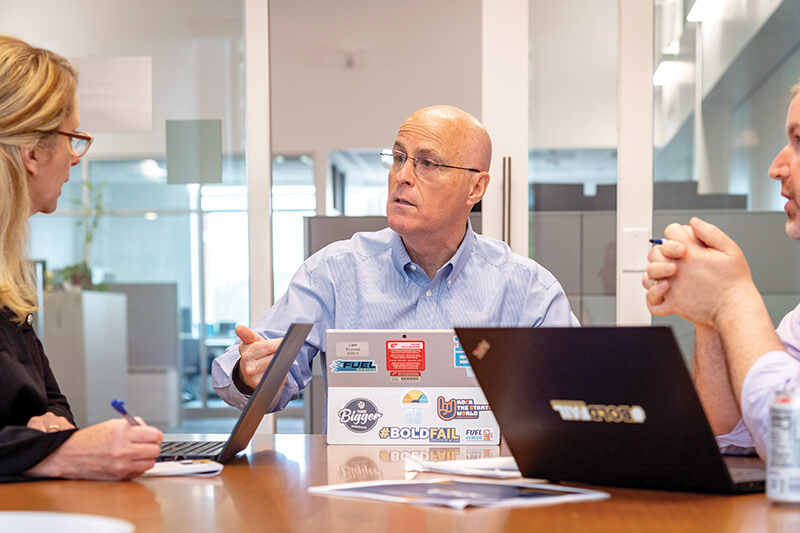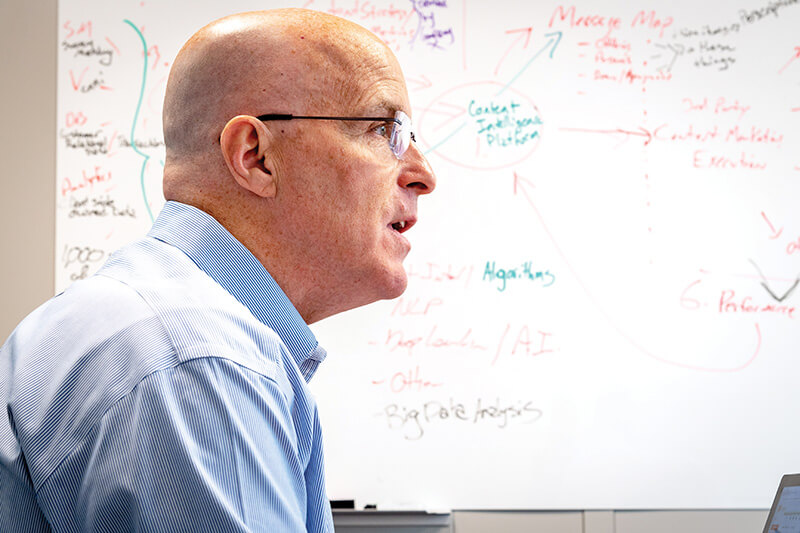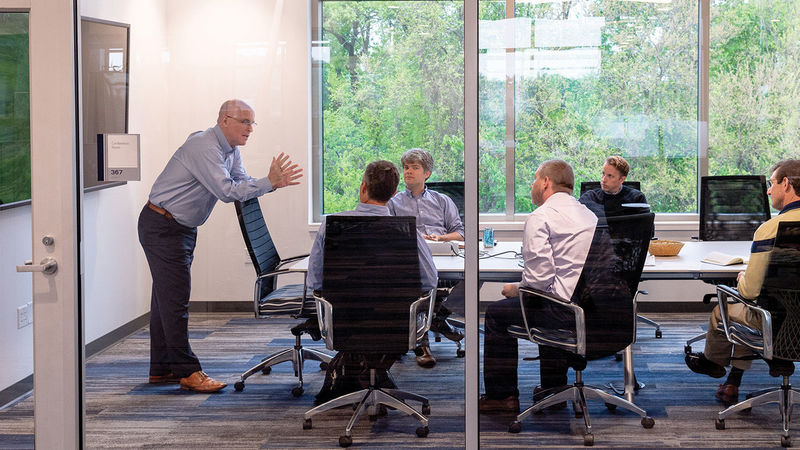Bryan Ritchie needs to be somewhere. This is an evergreen statement. There’s always a meeting to attend, a conference call to dial into, a presentation to make. Impromptu walk-and-talks fill the brief interludes as colleagues thread quick conversations through the narrow spaces in his calendar. Right now he has to leave for an appointment with a dean.
The frequent pinging of his phone serves as a high-tech triangle bell, calling him to what’s next, or inserting new decisions to make into his overstuffed mental inbox. At the center of the perpetual, unpredictable activity around him, he remains composed, even serene, able to see individual parts in complementary motion through an unceasing blur.
Ritchie started at Notre Dame a year ago March as the University’s first vice president and associate provost for innovation. He runs the Idea Center, the entrepreneurial centrifuge where faculty and student research gets spun into marketable companies.
 Photos by Matt Cashore '94
Photos by Matt Cashore '94
Things move fast. Maybe not fast enough for Ritchie’s taste yet, but faster than this sort of thing has ever been done at Notre Dame. Established in 2016, the Idea Center became the coordinating nexus among the University’s existing efforts to protect intellectual property and market the innovative technologies emerging from faculty laboratories and student projects. Positioning the center under the leadership of a new vice president emphasized the importance administrators were placing upon redefining and expanding research commercialization. Their search led them to Ritchie, who started the job in full stride and has kept running.
“We’re just really cranking on this. We’re at 18 startups now this year,” he says. “The most Notre Dame’s ever done is three.”
Those 18 have been culled from about 300 inventions sent through the Idea Center’s disclosure portal. In Ritchie’s rough estimate, around 65 percent of the ideas that come through in any given year don’t survive the first phase, which evaluates technical and commercial potential and the risks inherent in any new technology. After all the vetting has been done, he says, about 10 percent will have proven to “really have something.”
Like the innovation behind Structured Immunity, a company that grew out of Notre Dame biochemist Brian Baker’s work to engineer T cells to fight cancer. The effectiveness of T cells, which have long played an important role in research on cancer immunotherapies, has been limited by the damage they cause to healthy tissue. Structured Immunity’s technology helps partner pharmaceutical firms develop targeted treatments with fewer side effects.
Another startup percolating in the Idea Center comes from students, whose entrepreneurial enthusiasm infuses the place — almost 100 worked there in some capacity during the academic year. Resonado develops audio speakers using flat magnets, rather than typical round ones, creating a smaller, lighter product. After an internship with a South Korean company, Notre Dame student Brian Cho received permission to use its patented Flat Magnetic Speaker technology in the United States.
As a junior, Cho formed Resonado with sophomore Peter Moeckel and juniors Kunwoo Park and Erikc Pérez-Pérez to make portable, powerful Bluetooth speakers. With assistance from the center, the company exceeded its fundraising goals, expanded from four to eight employees, and became the first student startup to rent space in the innovation hub.
Pruning 300 ideas down to a sliver of viable companies requires a certain ruthlessness. Cool technology or the far-off promise of life-changing breakthroughs do not seduce the center’s evaluators. They conduct pre-mortems here, searching for the incurable technical flaw or fatal market misinterpretation. That’s the secret, Ritchie says: not picking winners, but identifying the losers early, before too much has been invested in vain.
“We like to think of ourselves as benevolent executioners,” he says, always keeping the door open for those cut loose to return, reborn. “Iterate. Pivot. Try again. Then bring it back.”
“Iterate and pivot” amounts to a motto in entrepreneurial vernacular. Failure is an occupational hazard, even a necessity, in producing successful innovations, which often emerge from the debris of false starts and malfunctions. With that in mind, #BOLDFAIL stickers adorn just about every laptop and much of the available surface area in the Idea Center.
“They’re all over the place,” notes James Thompson, associate vice president for innovation, as an institutional call to think big, accept the consequences, learn the lessons. To iterate and pivot.
Ritchie and Thompson, who previously worked together at the University of Utah, make a habit of that. At regular intervals, they scrutinize their procedures to figure out what they’re doing wrong and to try new approaches.
In one such discussion, they determined that the Idea Center had two predominant strengths: the power of its evaluation and investment process, and access to the range and depth of Notre Dame’s research expertise. So they reorganized their staff into teams that focus on discrete stages of an invention’s development, rather than assigning specialists to shepherd projects from start to finish as they had done before. For complex technical questions, there’s that network of Notre Dame experts standing by.
“We’re not industry-specific,” Ritchie sums up. “We’re process-specific.”
Some of the staff focus on early-stage technology development, others on risk assessment or market research, knowledge that can be applied across industries. The idea in front of them could be anything — from big data to nanotechnology, from turbomachinery to clean energy, from engineering T cells for more effective cancer treatments to using flat magnets to build a better speaker.
Within months, the center’s realignment paid off in a streamlined process, Thompson says, “really moving technologies forward at a much faster pace than before.”
The restructuring was a significant change in how the center does business, one of several that have marked Ritchie’s first year at Notre Dame.
“For those of us who have been here,” says Richard Cox, who has led Notre Dame’s technology commercialization efforts since 2008, “our heads have spun around a couple of times.”
Any vertigo from Ritchie’s dizzying changes has eased, and everybody now seems to be facing the same direction. They like the view.

“He has a vision that’s compelling,” Cox adds. “He has a lot of energy and enthusiasm for it, and so it’s really easy to say, ‘Yeah, that looks like exactly the right thing to do. Let’s do it!’”
Ritchie, for his part, never seems rushed or distracted despite all the hustle around him, just . . . accelerated, as if he’s programmed at a slightly faster speed. He listens, considers, comments in candid and comprehensive detail, engaged in the subject at hand, by all appearances oblivious to anything but the immediate moment, until one obligation starts to bleed into the next, then a switch flips in mid —
“Can we walk together?”
He’s up from his chair, sweeping around the end of his desk, arm extended both to usher out a visitor and invite him to continue the conversation in transit to the next meeting.
From the outside, the Idea Center’s red-brick buildings at Innovation Park — the original Leighton Hall and a recent addition, Quinn Hall — would blend into any office park anywhere. Inside, it looks and sounds like a movie set of a startup incubator. High ceilings and exposed beams. Couches and flatscreens. Glassed-in offices and conference rooms surrounding an archipelago of cubicles in an ocean of open space.
The staff speak an acronymic and jargony language. “TRL” means technology-readiness level. The phrase “fail forward” comes up so often that it starts to sound like one word.
Even the unit’s name, stylized as the IDEA Center, is an acronym for Innovation, De-Risking and Enterprise Acceleration, the allcaps an unintentional graphic metaphor for the volume at which Ritchie wants the work to reverberate. Not just as an echo of the success emanating from one University department, but as a reflection of its impact on the world.
As a Notre Dame operation, the center has an obligation to the ethics as well as the economics of its investments. That’s why, when a colleague drops by to ask about a prospective relationship with a company in the guns and ammunition industry, Ritchie declines on the grounds that it clashes with institutional values.
The fit between academic research and commercialization can be uncomfortable, too.
Step onto the balcony for a view across Angela Boulevard of a campus expanding south, toward the Idea Center. Part of Ritchie’s job is to get people over there thinking in this direction.
For 30 years, he’s operated in the median between academic research and tech entrepreneurship. He knows the potential and the tension.
Academic researchers develop technologies with life-changing potential, but their expertise often stops at the lab bench. Bringing an innovation to market is another skill set altogether, traditionally one of less interest to scientists in search of their next discovery.
“There’s a translation component between the research and the practical application, and that gap has to be filled,” Ritchie says. “And we’re filling that gap.”
His initial meetings with Notre Dame officials convinced him that they were willing to invest, in every sense of the term, in that complex and expensive undertaking. He’d heard the right things from plenty of universities and at first considered Notre Dame just another suitor whispering sweet nothings. What made the University’s overture different, he came to understand, was the extent of its commitment.
Rather than being a pet project of current administrators that could be de-emphasized under future leadership — which he had experienced before — Ritchie found the concept of research commercialization to be “deeply embedded in the desire of the trustees,” giving it the sense of permanence that he prioritized.
Notre Dame, of course, has the financial resources to back up its promises, along with a reputation and talent pool that interests potential investors. The strongest sign of the University’s redoubled emphasis on commercialization may lie in how it’s investing in some of the startups: an internal venture fund with Notre Dame as the general partner. Ritchie knows of no other university doing anything like it, and he’s been at the forefront of this field for some time.
He left Utah, where he led the university’s commercialization process, with more than 150 companies, 16,000 jobs and billions in regional investment to show for his five-year tenure. Before that he had been at Michigan State, spending 11 years in the economics department after having stepped off the computer-industry treadmill he had run for more than a decade to get a Ph.D. in political economy at Emory.
On paper, Ritchie’s career looks like a model of careful planning, move after strategic move positioning him in the sweet spot between groundbreaking basic research and the entrepreneurial talent that scales it into the marketplace. When ambitious students ask how he found his way, as if consulting an oracle, Ritchie can only laugh. In real time, it felt like a series of decisions to plug his nose and jump.
He had enough financial success early on to make the leaps more a matter of professional refreshment than risk, but in retrospect, he professes no foresight beyond the immediate splash promised from each step off the high dive. There was no plan.
Through the 1990s, he worked in the early days of video conferencing and on wireless computer devices — “a number of really cool companies, with cool technologies, I didn’t even realize how cool,” he says. “It was the internet of things before the internet of things was even around.”
After taking a buyout in 1996, with some consulting work still percolating on the side, he decided his CV, already listing an MBA from Brigham Young, needed a Ph.D.
“At that point in my life I was like, ‘Do I really want to die having said all I ever did in this world was build software and sell it? No, I really want to do more.’”
As in more meaningful, although the sheer amount of what he’s doing would fulfill the letter of his stated ambition. At Notre Dame, he found a place to satisfy the spirit of it as well, what he describes as a unique confluence of mission, resources and will. So off he went, forward, fast. He made his latest move with a few Utah colleagues in tow and the tools to overhaul the parts already in place.
“The last year has been . . . ,” he pauses, thinking or revving, one or the other. “It’s been a drag race.”
They have, in fact, adopted an auto-racing motif at the Idea Center — an IndyCar inside the front door, an evaluation process that adds cylinders as new technologies accelerate to market. Ritchie, the Roger Penske figure overseeing a team of fast drivers and hustling pit crews, sets the pace.
He hesitated not at all in establishing Idea Week, a sort of South by South Bend gathering of entrepreneurs and entertainers meant to promote the area, Notre Dame and beyond, as fertile ground for innovation and investment. Held in April, dozens of sessions featured speakers like Tony Hsieh, CEO of the shoe and clothing company Zappos, and Matt Rogers, inventor of the Nest thermostat. Events sprawled from South Bend to Elkhart, symbolic of the center’s intention to open its arms wide to the region, to stitch town and gown together in a stronger economic relationship.
A few weeks afterward, Ritchie considers the lessons learned from the inaugural Idea Week — “how to go out and raise money from sponsors . . . how to get the community involved more” — and the time and treasure required to put on an event of that magnitude. Those takeaways will be analyzed and applied next year, the essence of his approach to everything: Let’s try it and see.
During one early-morning meeting the conversation shifts, within a single sentence sometimes, between analysis of individual companies and thoughts about streamlining the center’s own methodology. Ritchie thinks of it as “a startup that’s helping startups,” so its procedures undergo the same scrutiny as the innovations that come over the transom.
“What if we took each of the critical components and we gave it a ranking?” he says, cutting through the static of constructive crosstalk among a handful of colleagues around a conference table. “Like TRL, what is it today? Strength of the management team, what is it, on some scale, weak to strong? Previous hits on milestones, track record, how well have they done up to this point? Amount that they’ve raised, just some indicators on the deal.”
Not a general impression, but a systematic measurement of categories, “very hard-hitting, quick” — Ritchie snaps his fingers — “just do an update on key metrics,” an at-a-glance overview of a company’s status that, by combining all that data, also would serve to bring the Idea Center’s big picture into focus.
What’s working? What’s not? Why? The questions they’re always asking in one way or another and trying to find new and better ways to answer.
At a pause in the discussion, Thompson closes his laptop and slides his chair back.
“Are we going to another meeting right now?” Ritchie asks.
“We are.”
Jason Kelly is an associate editor of this magazine.
